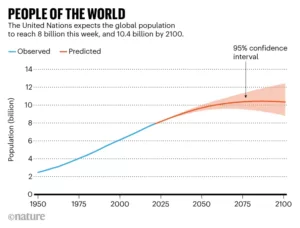According to United Nations models, the world’s population will have reached the eight billion mark in November 2022. This is particularly astonishing when you consider that less than a century ago, the planet was home to just two billion people.
- The rapid growth was driven by advances in health care and medicine that enabled more children to reach adulthood. At the same time, fertility rates remained high in low-income countries.
- But growth is slowing, and in a few decades the world’s population will begin to shrink, according to United Nations projections.
Today, nearly half the people on Earth live in places where lifetime fertility is below 2.1 births per woman – about the level needed for a population with low mortality to stop growing in the long term. - Most of the projected increase in global population between 2022 and 2050 is expected in just eight countries: the Democratic Republic of Congo, Egypt, Ethiopia, India, Nigeria, Pakistan, the Philippines and Tanzania.
- India is forecast to overtake China as the world’s most populous country in 2023.
Further reading:

Projected development of the world population
Source: https://www.nature.com/articles/d41586-022-03720-6